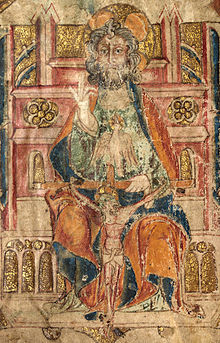Polytheism
In religions that accept polytheism, the different gods and goddesses may be representations of forces of nature or ancestral principles; they can be viewed either as autonomous or as aspects or emanations of a creator deity or transcendental absolute principle (monistic theologies), which manifests immanently in nature (panentheistic and pantheistic theologies).Although the term "henotheism" is controversial, it is recognized by scholars that the worship of a single God accompanied by belief in other deities maintains the principle of polytheism.Vedanta, the most dominant school of Hinduism, offers a combination of pantheism/panentheism and polytheism, holding that Brahman is the sole ultimate reality of the universe, yet unity with it can be reached by worshipping the innumerable deities that represent the Supreme Absolute Truth.In modern times, the term polytheism was first revived in French by Jean Bodin in 1580, followed by Samuel Purchas's usage in English in 1614.[9] "Hard" polytheism is the belief that gods are distinct, separate, real divine beings, rather than psychological archetypes or personifications of natural forces.The gods of polytheism are in many cases the highest order of a continuum of supernatural beings or spirits, which may include ancestors, demons, wights, and others.Hellenic Polytheism extended beyond mainland Greece, to the islands and coasts of Ionia in Asia Minor, to Magna Graecia (Sicily and southern Italy), and to scattered Greek colonies in the Western Mediterranean, such as Massalia (Marseille).Jordan Paper, a Western scholar and self-described polytheist, considers polytheism the normal state of human culture.On the other hand, he asserts, monotheistic missionaries and scholars were eager to see a proto-monotheism or at least henotheism in polytheistic religions, for example, when taking from the Chinese pair of Sky and Earth only one part and calling it the King of Heaven, as Matteo Ricci did.[53] Mormons teach that "The glory of God is intelligence" (Doctrine and Covenants 93:36), and that it is by sharing the Father's perfect comprehension of all things that both Jesus and the Holy Spirit are also divine.The Puja (worship) of the pratima is like a way to communicate with the formless, abstract divinity (Brahman in Hinduism) which creates, sustains and dissolves creation.[56] It was believed that after the consecration ritual, the idol no longer remained as stone or metal and attained a temporary or permanent state of divinity.Academically speaking, the ancient Vedic scriptures, upon which Hinduism is derived, describe four authorized disciplic lines of teaching coming down over thousands of years.He can be and is often approached through worship of Prathimas, called "Archa-Vigraha", described in the Vedas as identical to his various dynamic, spiritual Forms.The fifth disciplic line of Vedic spirituality, founded by Adi Shankaracharya, promotes the concept that the Absolute is Brahman, without clear differentiations, will, thought, or intelligence.In the Smarta denomination of Hinduism, the philosophy of Advaita expounded by Shankara allows veneration of numerous deities [citation needed] with the understanding that all of them are but manifestations of one impersonal divine power, Brahman.Therefore, according to various schools of Vedanta including Shankara, which is the most influential and important Hindu theological tradition, there are a great number of deities in Hinduism, such as Vishnu, Shiva, Ganesha, Hanuman, Lakshmi, Kali, Parvati, Durga, Rama, Krishna but they are essentially different forms of the same "Being".Ram Swarup, for example, points to the Vedas as being specifically polytheistic,[57] and states that, "only some form of polytheism alone can do justice to this variety and richness."[58] Nasadiya Sukta (Hymn of non-Eternity, origin of universe): There was neither non-existence nor existence then; Neither the realm of space, nor the sky which is beyond; What stirred?-Rig Veda 10.129 (Abridged, Tr: Kramer / Christian) Some Hindus construe this notion of polytheism in the sense of polymorphism—one God with many forms or names.The Rig Veda, the primary Hindu scripture, elucidates this as follows: They call him Indra, Mitra, Varuna, Agni, and he is heavenly nobly-winged Garutman.[59] Prods Oktor Skjærvø states Zoroastrianism is henotheistic and "a dualistic and polytheistic religion, but with one supreme god, who is the father of the ordered cosmos".According to many scholars, Tengrism was originally polytheistic, but a monotheistic branch with the sky god Kök-Tengri as the supreme being evolved as a dynastical legitimation.[62][63][64] It is suggested that Tengrism was a monotheistic religion only at the imperial level in aristocratic circles, [65][66][67] and, perhaps, only by the 12th–13th centuries (a late form of development of ancient animistic shamanism in the era of the Mongol empire)."[78] Reconstructionist polytheists apply scholarly disciplines such as history, archaeology, and language study to revive ancient, traditional religions that have been fragmented, damaged, or even destroyed, such as Norse Paganism, Roman and Celtic.A reconstructionist endeavors to revive and reconstruct an authentic practice based on the ancestors' ways but workable in contemporary life.It is quite compatible with this argument that God should have died long ago, or that he should have turned his attention to other parts of the Universe", and notes in the same breath that "there is nothing in the facts to suggest that there is only one such being".


TheismAgnosticismApatheismAtheismClassical theismHenotheismIetsismIgnosticismMonotheismMonismDualismMonolatryKathenotheismOmnismPandeismPanentheismPantheismTranstheismBrahmanCreatorDemiurgeFatherForm of the GoodGreat ArchitectMotherSummum bonumSupreme BeingSustainerTrinityTawhidPersonalUnitarianismAbrahamicJudaismChristianityBaháʼí FaithMormonismMandaeismIndo-IranianHinduismBuddhismJainismSikhismYungdrung BonZoroastrianismChineseShangdiHongjun LaozuExistenceGenderOmnibenevolenceOmnipotenceOmnipresenceOmniscienceAseityTranscendenceBeliefEsotericismFideismGnosisHermeticismMetaphysicsMysticismPrayerRevelationWorshipEuthyphro dilemmaGod complexGod geneTheologyOntologyProblem of eviltheodicyReligionphilosophyPortrayals of God in popular mediapantheongoddessesreligious sectsritualssingular Godtranscendentancestral principlesemanationscreator deitytranscendentalabsolute principlemonisticimmanentlypanentheisticpantheisticmonolatristskathenotheistsAbrahamic religionsprehistoryancient Egyptian religionancient Mesopotamian religionClassical antiquityancient Greek religionancient Roman religionethnic religionsGermanicSlavicBaltic paganismNative American religionsTaoismHellenism (modern religion)ShenismChinese folk religionShintoSanteríaTraditional African religionsneopaganpantheistspanentheistshenotheistmonotheistsmonistVedantaPhilo of AlexandriaGentilespagansJean BodinSamuel PurchasInterpretatio graecaarchetypes
